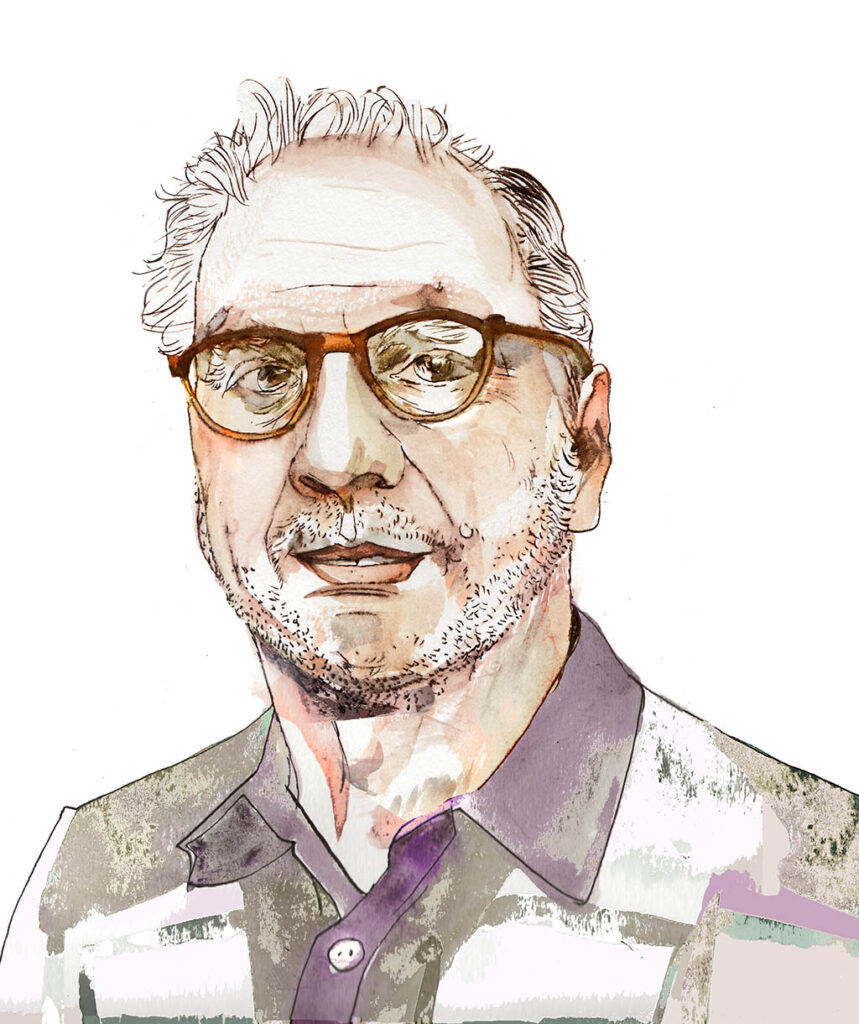Renowned microbiologist’s battle against the coronavirus gets personal

About one week after testing positive for COVID-19 in early April, famed virus hunter Peter Piot, MD, PhD, checked into the Royal London Hospital with a high fever, extreme exhaustion and mind-numbing headaches. He wasn’t sure he would ever leave.
After years of tracking down dangerous and elusive viruses, including AIDS and Ebola, a new virus had finally tracked him down. “Revenge of the viruses,” he thought to himself with grim humor. His wife, Heidi Larson, watched as they rolled Piot away from her and through the double doors to the isolation ward.
“It’s a hard feeling when someone you love is very ill, and they’re going to have to be alone,” said Larson, PhD, an anthropologist, who traveled with her husband to Sierra Leone during the Ebola outbreak in 2014. The separation from her husband reminded her of what Ebola patients’ families went through.
Piot was in the hospital, struggling for his life, for seven days and nights. Three other men with the same virus shared his hospital room. All three were diabetics and ethnic minorities, two categories known to increase the risk of COVID-19 complications in the United Kingdom.
Because of his age, 71, Piot was also in a high risk category, but he had no pre-existing conditions, jogged regularly and was rarely ill. He hadn’t taken a sick day in 10 years.
“I became a patient once the doors closed behind me,” Piot said. “I wasn’t trying to be a patient and a physician. I was so exhausted I couldn’t think properly. At my darkest moments I thought, ‘Maybe I won’t get out.’”
Piot, who grew up in Belgium, has spent much of his career traveling to Africa and Asia to fight infectious disease. He was on an international team that discovered the Ebola virus in 1976 in northern Democratic Republic of the Congo (then referred to as Zaire). From 1991 to 1994, he was president of the International AIDS Society, then the first director of the U.N. Programme on HIV/AIDS, called UNAIDS. He said that he has great respect for viruses, but that he underestimated this one.
“When I first got sick, I thought, ‘Oh, this is just a typical viral thing,’” he said. “It was clearly much, much worse than I imagined.”
Taking precautions against the virus
Shortly after the World Health Organizationn declared the coronavirus a pandemic on March 11, Piot and Larson started isolating themselves physically from others, conducting business from their home in London. Britain went into lockdown on March 23, but it was already too late for Piot.
He doesn’t know where he caught the virus; it could have been so many places. As director of the London School of Hygiene & Tropical Medicine, Piot’s duties keep him in the public eye. Prior to isolating, he was giving talks, attending meetings, chatting with students and, as a self-proclaimed foodie and wine lover, often eating out.
On the evening of March 19, Piot came down with a high fever, muscle aches, a sore throat and a splitting headache. He didn’t have a cough, but, weirdly, his scalp burned when he touched it. He figured he had COVID-19.
At first, he continued to work. But that became harder every day. He lost his appetite. Getting out of bed in the morning was a struggle. The growing fatigue and the headaches consumed him. Yet, he couldn’t easily get a test for the virus.
“It’s extremely hard to get testing in London,” he said. “I didn’t meet the criteria because I didn’t have a cough. So I went to a private clinic, and I tested positive. This lack of access to testing is really scandalous.”
As the director of a university, Piot is responsible for overseeing the move to online teaching, so he refused to rest after testing positive. “We were in crisis,” he said.
Eventually, though, working was no longer an option.
“It felt like this virus was in every single cell in my body. Maybe it was. We know today that it definitely affects other organs, rather than just the lungs.”
When his fever spiked to 104 degrees, he and Larson finally took off in a taxi for the emergency room. X-rays of his lungs showed he had bacterial pneumonia. Even though he wasn’t coughing and wasn’t short of breath, his oxygen levels were frighteningly low. He was given oxygen through a mask, antibiotics for the pneumonia and blood thinners — a response to then-growing worries about blood clots causing strokes in coronavirus patients.
By the time he reached the hospital, he no longer tested positive for COVID-19 so he was relieved that he had previously been tested. It’s not unusual for symptoms to linger after testing negative for the virus, he said.
While he was in the hospital, Piot was grateful that he could talk to his wife and grown children over FaceTime during the day. But the nights were long.
“I was really scared I’d have to go on a ventilator,” he said. “I was still following the medical literature, and there was increasing evidence of high mortality for people on ventilators.”
Fortunately, the high-flow oxygen was enough to keep him alive.
After he was released from the hospital, he took an above-ground train ride home. It was a nearly empty train and he was careful to wear his mask, he said. He wanted to soak in being outside and being alive.
Thriving in a ‘no future’ vocation
When Piot was a medical student at Ghent University in Belgium, a professor warned him against a career in infectious disease, saying there was no future in the field. It was the 1970s, when many thought that antibiotics and vaccines would wipe out all infectious disease.
Piot ignored the advice and went on to earn his PhD in clinical microbiology at the University of Antwerp. The era of infectious disease did not subside. Instead, antibiotics became less effective, an anti-vaccine movement grew and society became increasingly mobile, which combine to create prime conditions for infectious diseases to spread.
Meanwhile, Piot and others in his field began to predict that pandemics would strike.
“We’ve all predicted that one day something like this would happen,” he said. “I gave speeches about it. I asked ‘Are we ready for the pandemic?’ The answer was no. I always thought, though, that it would be an influenza virus. Instead it turned out to be a coronavirus.”
Early in his career, when Piot was a senior fellow at the University of Washington, he worked with Lucy Tompkins, MD, PhD, now a professor of infectious diseases at Stanford, and the late Stanley Falkow, MD, whom he considered a mentor. Falkow, a renowned microbiologist who later joined the Stanford faculty, discovered the molecular mechanisms of many infectious diseases.
“Stan told us to put yourself in the head of the microbe,” Piot said. “Its purpose is to find a living host — a plant, an animal or a human being — to infect. Viruses can only survive in a living cell. In other words, viruses will continue to try to infect more people all the time, otherwise they’ll die.”
This coronavirus has proven to be an expert at infecting people, easily jumping from one victim to the next, he said.
SARS, another coronavirus, enters the body and goes straight to the lungs. But the COVID-19 virus stays in the throat and nose longer, making it easier to spread. People infected with COVID-19 have been shown to be contagious for about two days before showing symptoms, an unusually long time. In addition, many people infected with the coronavirus remain asymptomatic, yet they are still able to spread the disease.
“This is a nightmare to control,” Piot said. “If you only deal with people with symptoms, you’re going to miss quite a few people.”
Still an enigma
While the world struggles to control COVID-19, much about it remains unknown, Piot said. It’s that uncertainty that’s hardest for everyone, including scientists and world leaders, to manage.
After Piot returned home, he was still physically and emotionally fragile, and was easily fatigued. But his fever had gone and his oxygen levels were almost normal.
Then a new set of symptoms slapped him back down. His immune system went into overdrive, he said, and his oxygen levels started jumping around.
“We live in an old house with four floors,” he said. “We’re going up and down all the time.” When that became a problem, he made an appointment at University College London Hospital for a second round of tests. That was April 19, a week after he had been discharged.
“I was so scared that I might be admitted to the hospital again,” he said. “They did the blood work and ran a CT scan. I saw the images of my lungs: They looked opaque, much worse than when I was admitted with the acute infection the first time.”
Piot had what’s called a hyper-inflammatory immune response. His heartbeat was irregular and he was diagnosed, this time, with interstitial pneumonia caused by inflammation in the lungs. Doctors put him on high levels of prednisolone — a steroid that dampens the immune response — and sent him home to rest.
“I really think the personal story is absent from the conversation. In the U.K., at least, it’s all about flattening the curve. It’s almost an afterthought how to save people.”
His symptoms waxed and waned for two months. He worried the illness would become chronic, though he was relieved that, as a U.K. resident, his medical costs (except for that original coronavirus test) were covered by the National Health Service. Finally, he began to get better.
“It was so very frustrating,” he said. “I couldn’t do anything but be a patient and rest.” During his recuperation, Piot was interviewed for a story that ran in a Belgian magazine describing how the famous virus hunter remained sick with the coronavirus after two months. Science and The New York Times ran similar stories, spreading the story wide.
Hundreds of messages flooded Piot’s email box, many from people whose COVID-19 symptoms lingered for weeks, sometimes months. “We are going to see a whole generation of people coming out of this with chronic conditions. I’ve probably got a bit of lung fibrosis. Fortunately though, no kidney problems.”
By the last day of June, Piot said, he was feeling 95% better and went for his first jog in months. He was gardening again, and enjoying wine. He joked that people who know him will understand how sick he was to go six weeks without it.
He was also working from home, though he still grew fatigued in the evenings. In addition to running a university, Piot works as a coronavirus adviser to European Commission President Ursula von der Leyen. World leaders in industry and politics also contact him for advice about how to protect against this virus.
His struggle to survive has given him a whole new set of insights, he said.
“I really think the personal story is absent from the conversation,” he said. “In the U.K., at least, it’s all about flattening the curve. It’s almost an afterthought how to save people. This is about the people.
“It’s really touched me personally how invasive this virus — one that I so underestimated — can be. I’m more dedicated than ever to fight this virus.”

